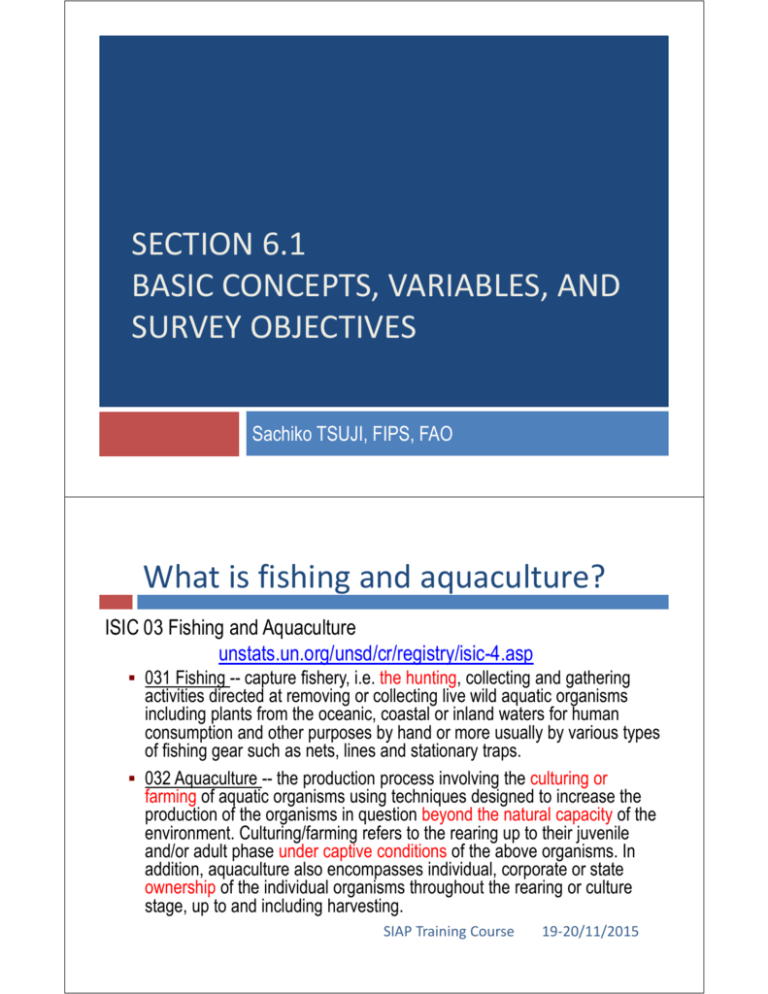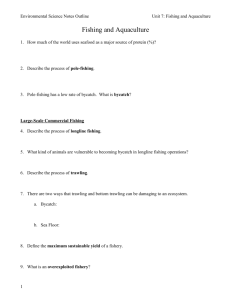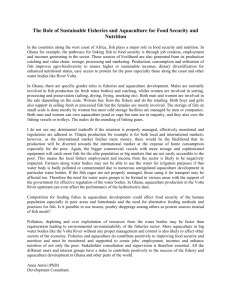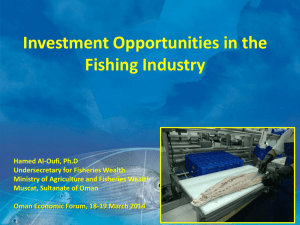SECTION 6.1 BASIC CONCEPTS, VARIABLES, AND
advertisement

SECTION 6.1 BASIC CONCEPTS, VARIABLES, AND SURVEY OBJECTIVES Sachiko TSUJI, FIPS, FAO What is fishing and aquaculture? ISIC 03 Fishing and Aquaculture unstats.un.org/unsd/cr/registry/isic-4.asp 031 Fishing -- capture fishery, i.e. the hunting, collecting and gathering activities directed at removing or collecting live wild aquatic organisms including plants from the oceanic, coastal or inland waters for human consumption and other purposes by hand or more usually by various types of fishing gear such as nets, lines and stationary traps. 032 Aquaculture -- the production process involving the culturing or farming of aquatic organisms using techniques designed to increase the production of the organisms in question beyond the natural capacity of the environment. Culturing/farming refers to the rearing up to their juvenile and/or adult phase under captive conditions of the above organisms. In addition, aquaculture also encompasses individual, corporate or state ownership of the individual organisms throughout the rearing or culture stage, up to and including harvesting. SIAP Training Course 19‐20/11/2015 Fishing or aquaculture, or else? Trouble to define? Cultured fry (baby fish) released to the lake Fish trapped in rice fields after receding flooded water Ornamental fish Fish caught with traps being kept in irrigation pond Corals, sea cucumber, pearls Whales, dolphines, sea turtles, seals Lotus seeds, lotus roots, water chestnut SIAP Training Course 19‐20/11/2015 Statistical separation of Fishing and Aquaculture Natural environment Farming Culture-based Fishery Aquaculture Capture-based Aquaculture Capture fishery Market/other sectors Aquaculture production Capture production Key rules – reporting production: Which country to report (i.e. attribute of production) ? Fishing – flag of vessels: Aquaculture – location of production unit Fish produced by Aquaculture company of country A in the lake of country B Fish harvested by Fishing company of country A within the country B EEZ What to measure in production ? Live-weight equivalent Exception – ornamental fish, whales reported in number Species specific > fish resource management Inland or Marine? Fishing – based on location of harvest Aquaculture – based on water source SIAP Training Course 19‐20/11/2015 Key concepts and classifications: CWP Handbook: http://figisapps.fao.org/FIGISwiki/index.php/CWP#Revision_of_CWP_Handbook Standard concepts, methodologies and classifications CWP Classifications: FAO Major Area: Aquatic Animals and Plants (ASFIS) Species Group (ISSCAAP) Fishing Vessel (ISSCFV): Fishing Gear (ISSCFG): Fishery Commodities (ISSCFC): Catch diagram: SIAP Training Course 19‐20/11/2015 What information need to collect? Impacts of fisheries operations to natural resources/ environment: Status and changes of operations Status and changes of biological environment (targeted and nontargeted components) Status and changes of physical environments Fisheries specific Contribution of fisheries sector: Food security Social aspects (number of people supported by fishery sector) Economic aspect (contribution to national GDP) Impacts from other sectors/ environment: Interaction with other sectors (e.g. inputs, outputs, competitions with aquaculture and agriculture) Shift and changes of environments supporting fisheries sector (e.g. habitat deterioration, climate changes impacts) Global Strategy SIAP Training Course 19‐20/11/2015 Operations Shift of basis External Factors Interaction Target Impact of Fishing operation Non-target High demand in MCS >> high priority : international managed fisheries > marine large scale > coastal, aquaculture, inland (mostly small scale) > subsistence, recreational GDP Physical Env. Social and Weak in data on social economic aspects and environmental impacts Economic Contribution Lack of comparability and compatibility with other Employment Food sectors’ statistics Large Marine Small Marine Inland Group discussion: Identify any troublesome cases of your countries’ experiences Provide response as a group SIAP Training Course G1 G2 Fish ponds – boundary, definition Owner of boats Operation in group of people (nationality) Illegal small HH, operating but not reported River fishing – (lack of) controlling mechanism Illegal fishing, protected area,-- tool, methodologies to control Number of species declining every year Population declining Construction of hydro-power Fishing power/ capacity/ area declining (concession) G3 Local and international illegal fishing illegal transhipment Natural disaster Coral destruction Belong to multiple department responsibilities (e.g. crocodiles) 19‐20/11/2015 Production come out from illegal activities: Country cannot take responsibility for any illegal actions. Therefore, in theory, the products from illegal activities are not included in any countries’ (official) statistics. The extent of such illegal production can be estimated/ evaluated for management and analytical purpose. Even in this case, there is no attribute for these illegal production. Complex international ownership (boats/ companies): Basic principle will be applied to identify the attribute, i.e. flag for a boat for capture and physical location of harvest for aquaculture production, regardless the complexity of ownerships.







